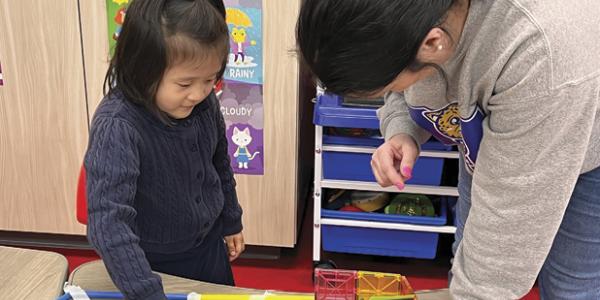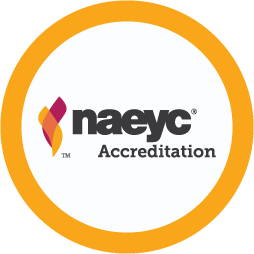Debunking Seven Myths About STEM

You are here
As early childhood educators, it’s important to clear up some myths about early STEM education. This helps us communicate effectively with administrators, families, stakeholders, and the public, ensuring shared understanding and support for our teaching practices. Following, I debunk some common STEM myths so that you can feel confident embracing STEM in your setting.
1. STEM is only for certain people. STEM isn’t just for boys, older children, students identified as gifted, or those destined to become scientists or mathematicians. It’s for everyone, regardless of age, gender, race, culture, or abilities. Children’s attitudes about STEM and their own identities as STEM learners form early. That’s why it’s important to positively shape these attitudes toward science, technology, engineering, and math in the early years.
Early childhood educators can simplify advanced concepts for preschool and kindergarten children by using age-appropriate language and introducing activities and materials related to everyday experiences. For example, when introducing concepts like balance and stability, teachers can use phrasing such as stay upright or not fall over. They can use multiple modalities (gestures, images, sounds) and words in English and in children’s home languages to aid in conceptual understanding. Experiences can be adjusted by changing materials and tools to increase or decrease complexity. The key to supporting all learners is to carefully observe and gather information about children’s interests, assets, and needs; reflect; and respond with challenging yet achievable experiences.
2. STEM can only be taught by those with advanced degrees in a STEM discipline. STEM teaching in early childhood doesn’t demand specialized degrees in science or math, and many activities throughout the learning day incorporate STEM skills. For example, cooking activities include math (measurement), gardening links to science (life cycles), and tinkering with cars or woodworking involves elements of physics and engineering (force, motion, balance, and stability). Early childhood teachers shouldn’t feel pressure to have all the answers when teaching STEM. Instead, it’s about asking the right questions to spark curiosity and offering responsive scaffolds to sustain inquiry. For example, when exploring ramps and rollers, a teacher might say, “Hmmm . . . I wonder how we might make the roller move faster or slower?” This type of open-ended questioning encourages children to think critically, investigate, and discover answers through hands-on explorations.
3. Early childhood STEM is only about teaching science and math. This is a common misconception. Children learn in integrated ways: everyday situations and problems are navigated using wide-ranging and interconnected knowledge and skills. Within a high-quality, integrated curriculum, children will develop skills and knowledge within and across all content areas and developmental domains. STEM education is critical to laying the groundwork for children’s overall growth and learning by prioritizing skills like problem solving, critical thinking, creativity and expression, and collaboration.
 4. STEM is only for certain times of the day. STEM isn’t confined to specific time slots in the daily schedule. Rather, it’s about taking advantage of teachable moments. By looking at their daily schedules through a STEM lens, teachers can intentionally plan STEM experiences while also recognizing the possibility for exploration during routines and self-directed play indoors and outside.
4. STEM is only for certain times of the day. STEM isn’t confined to specific time slots in the daily schedule. Rather, it’s about taking advantage of teachable moments. By looking at their daily schedules through a STEM lens, teachers can intentionally plan STEM experiences while also recognizing the possibility for exploration during routines and self-directed play indoors and outside.
When planning STEM experiences, teachers don’t need to perform “magic trick” science demonstrations (like the flashy baking soda-and-vinegar volcano). Children don’t always understand why these “wow” moments are happening. It’s better to engage children in hands-on activities where they can explore and discover STEM concepts themselves, with a teacher’s support and instruction.
5. STEM is only for the classroom. STEM-rich experiences can continue in community and home settings. Teachers can share simple, feasible STEM activities with families through newsletters or emails. (For example, when studying light and shadows at school, encourage families to play shadow tag outside or use flashlights inside to make shadows larger and smaller.) Informal community settings, like public libraries, parks, and children’s museums, also offer rich experiences that may include practical STEM applications. These venues can ignite STEM interest, allowing families to playfully, joyfully explore.
6. STEM requires expensive kits, materials, and tools. STEM activities don’t require fancy equipment or large budgets. The emphasis is on creativity and problem solving, not expensive resources. Everyday materials like cardboard boxes and other reusable items can be transformed into valuable teaching and learning tools. Families, local businesses, and/or community organizations can be tapped to collect recyclables or
loose parts for STEM experiences.
Using familiar materials in unfamiliar ways is important because it promotes creativity, conceptual understanding and factual knowledge, innovation, and problem-solving skills—all while building skills in observation, collecting evidence, forming and revising hypotheses, and more. This approach is not only affordable, it also nurtures children’s abilities to adapt, experiment, and find novel solutions to challenges—essential skills for academic and
real-life situations.
7. STEM is too dangerous for young children. Knowing the children you teach is essential for ensuring safety during early STEM experiences and for customizing safety measures to meet each child’s strengths, interests, preferences, and needs. Here are a few considerations:
- Follow and build upon class rules. Many teachers start with a simple rule like “be safe” and then add little rules related to safety (such as “walk with scissors pointing down” or “wear goggles”).
- Use child-safe materials and equipment. Select tools and materials that are appropriate for young children. Provide child-sized goggles and cut-resistant gloves. In addition, tools like ultra low-temperature glue guns or child-safe cardboard cutters empower children and open up a world of possibilities for three-dimensional creative (and safe) construction.
- Introduce new tools and techniques gradually. Introduce the tool or material during a group discussion: “What do you notice about this tool? What can it be used for? What might go wrong? What parts are sharp or pointy? What rules should we add to be safe?” Begin with simple tasks where children can practice using a new tool; for example, cutting scrap pieces of cardboard with a cardboard cutter or using a low-temperature glue gun to add found items to a sculpture. Follow up with individualized scaffolding to ensure each child understands and can use the materials and tools to actively engage in STEM experiences.
STEM is inclusive—reaching all ages and environments and fostering curiosity and resilience. By dispelling these seven myths, we pave the way for each and every child to engage in playful, equitable STEM learning.
Photograph: courtesy of the author
Copyright © 2024 by the National Association for the Education of Young Children. See permissions and reprints online at NAEYC.org/resources/permissions.

 This article supports the following NAEYC Early Learning Programs standards and topics
This article supports the following NAEYC Early Learning Programs standards and topics
Standard 2: Curriculum
2A: Essential Characteristics
2D: Language Development
Standard 3: Teaching
3G: Using Instruction to Deepen Children’s Understanding and Build Their Skills and Knowledge
Cate Heroman is one of the founders of Knock Knock Children’s Museum in Baton Rouge, Louisiana, renowned for its emphasis on early literacy and early STEAM education. A nationally recognized educator and author of numerous publications, she has been an early childhood educator, state administrator, trainer, facilitator, keynote speaker, and developer of curriculum and assessment materials.
